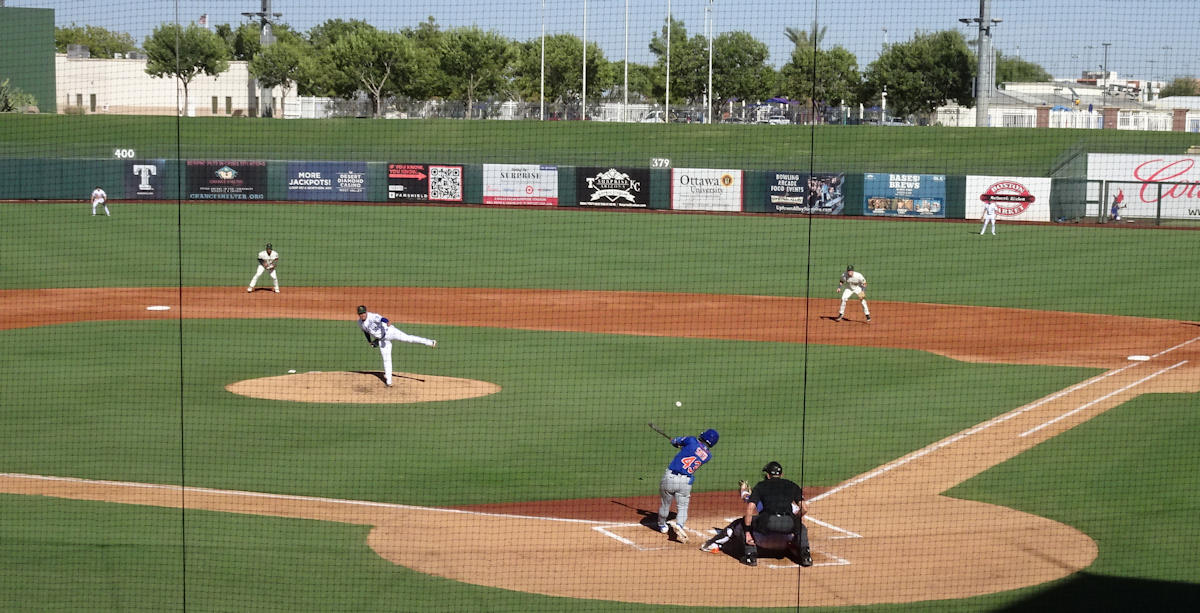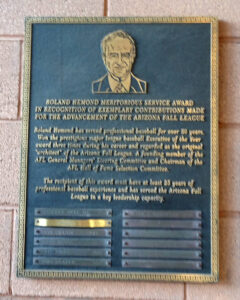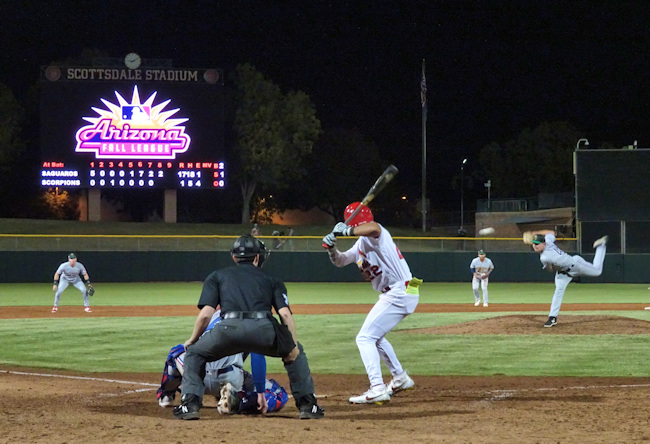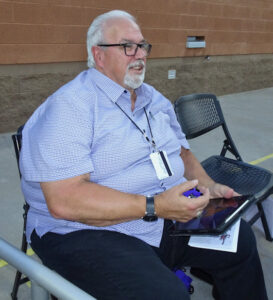
Joe Mock
Special to USA TODAY
All rights reserved on text and photos
MESA, Ariz. When he was a high schooler in Phoenix, Jacob Berry says he enjoyed watching prospects like Bo Bichette and Vladimir Guerrero, Jr. in the fall developmental league played in the area’s spring training complexes.
Following an impressive stint at LSU, the Miami Marlins selected Berry 6th overall in the 2022 amateur draft. He’s now the team’s 4th best prospect according to MLB Pipeline.
This August, an injured foot ended his second pro season prematurely. Now healthy, the switch-hitting corner infielder is thrilled to have the chance to hone his skills in the Arizona Fall League, the same developmental league he’d watched from the bleachers.
“I’m really grateful to be here,” says Berry, currently a member of the AFL’s Peoria Javelinas. “I know a lot of good players have come through here. I’m just excited the Marlins gave me the opportunity.”
Roland’s idea
Roland Hemond was an executive with six different MLB franchises. His illustrious career earned him the Buck O’Neil Lifetime Achievement Award from the Baseball Hall of Fame in 2011.
 While with the Baltimore Orioles in 1990, he envisioned a new approach to developing the talent that every big-league team had in its organization. Hemond suggested squads of prospects play after the Minor League seasons concluded in early September. Major League Baseball backed the idea, and fall developmental leagues were tried in Maryland/Delaware, Hawaii, California and Arizona. This allowed the big-league clubs to have more coaching control over their prized youngsters than if they played in Caribbean winter leagues.
While with the Baltimore Orioles in 1990, he envisioned a new approach to developing the talent that every big-league team had in its organization. Hemond suggested squads of prospects play after the Minor League seasons concluded in early September. Major League Baseball backed the idea, and fall developmental leagues were tried in Maryland/Delaware, Hawaii, California and Arizona. This allowed the big-league clubs to have more coaching control over their prized youngsters than if they played in Caribbean winter leagues.
Of the four leagues, the one in Arizona had staying power. Hemond’s idea has been such a hit that this autumn, the Arizona Fall League is playing its 30th season.
Although the particulars have evolved over the years, the concept is simple. Each MLB club sends seven or eight of its Minor Leaguers to train and play a 32-game schedule. There are six teams in the AFL, with each squad stocked by five MLB teams. Berry’s team, for instance, features prospects from the Guardians, Mariners, Marlins, Rays and Padres.
The Javelinas Play home games at the Peoria Sports Complex, which is the spring-training home of the Mariners and Padres. The other parks in the AFL are also spring-training venues: Scottsdale Stadium; Surprise Stadium; Camelback Ranch (Glendale); Sloan Park (Mesa); and Salt River Fields (Scottsdale).
While attendance will never approach the levels of spring-training exhibitions, the crowds during the fall have grown steadily over the 30 seasons. In the 1990s, the handful of scouts who attended games typically outnumbered ticket-buying fans. Today, the AFL’s attendance, merchandise sales and overall revenue are at all-time highs. “This is a 30-year overnight sensation,” quips league coordinator Jeff Rodin.
Unanimous support
Adorning the walls of the main concourse of Scottsdale Stadium are plaques honoring inductees in the Arizona Fall League Hall of Fame. Here you’ll find names like Mike Trout, David Wright, Max Scherzer, Buster Posey and dozens more.
In addition to the players honored with plaques are hundreds more who went on to play in the Majors after a stint in the AFL. Past MVPs of the league include Nolan Arenado (2011, Rockies, Cardinals), Kris Bryant (2013, Cubs, Giants, Rockies), Ronald Acuña Jr. (2017, Braves), Royce Lewis (2019, Twins) and emerging star Heston Kjerstad (2022, Orioles).
In fact, of the 312 players on the rosters of the twelve teams that made MLB’s playoffs this year, 121 are alumni of the AFL. The Phillies led the way with 16 alums, including breakout star Bryson Stott (played in the AFL in 2021) and newcomer Johan Rojas (2022).
Before the Rangers called up Evan Carter on September 8, the team was considering sending him to the Fall League. Instead, Carter has been busy leading his team to this year’s World Series.
This speaks to the quality of prospects that fans can watch and interact with at AFL games.
“The Fall League has always been a tool for the clubs to develop their best players, to give them the chance to play against the other best prospects,” observes Chuck Fox, director of the AFL.
“While every team has a different opinion on which players to send here, there’s unanimous support from all 30 clubs,” he adds. “And a club would not send a player here who’s not in their plans.”

He notes that the Cardinals select the players to participate as a reward for what they accomplished during the regular season. “A kid like (Victor) Scott (batting in the photo above) might not be in the Top 100 Prospects list, but he’s here as a reward for his performance, leading all of baseball in stolen bases. It says to him, ‘Hey, you’re in our plans.’”
The largest plaque on the wall at Scottsdale Stadium is reserved for Roland Hemond, who passed away in 2021. “This league has come a long way from the vision of Roland to what it is today,” says Fox.
Trying new things
Fox concedes that it’s a challenge gaining brand recognition for the AFL at this time of year “because all of baseball’s eyeballs and resources are watching the (MLB) playoffs right now. That means we have to be organized, hire good people, and be creative.”
Part of being creative is providing “the full baseball experience,” according to league administrator Donna Petersen.
“We’re offering many of the things you’d experience in a Major League park, while offering access to players,” she explains. “Our attendance is growing because we offer all these things, like great baseball, the merchandise, the giveaways, T-shirt tosses. It’s the full package.”
There is also more community involvement around Central Arizona. Petersen says there’s now a partnership with a local Little League as well as the Boys and Girls Clubs, “plus we now have day games on Wednesdays because we know there are early releases (from school) that day. What we’re trying to do is be accessible to the community.”
Adds Fox, “We’re trying to develop tomorrow’s fan.”
To offer fans more opportunities to enjoy the Fall League, special events have been worked into the schedule. This year, a triple-header of games was played on October 14 at the spring-training park in Goodyear, and an impressive 1,411 fans attended. During the weekend of November 4-5 at Sloan Park in Mesa, there will be a home-run-hitting contest and the AFL Fall Stars game. Last year’s all-star event was the most attended game of the season, drawing 1,858 fans.
Petersen is proud that the “development goes far beyond the players. We’re developing new team ops, new merchandise coordinators, even broadcasters. The AFL is a developmental league across the board. This is great for people to figure out their passion in baseball.
“It’s a great place to try new things.”
An example of this are the rule changes implemented in the Majors this year. “Bigger bases, no shifting, the pitch clock – all were refined here,” notes Fox. “We were making enhancements, while still keeping it the same game.”
Aligning the work schedule
While the Fall League has always been helpful to young players, coaches, umpires, and future front-office hires, those in the stands – scouts and fans – are showing up in increasing numbers.
 Will George (see photo) has been in baseball for 47 years as a player, coach and now scout. “I love the Fall League because I get to see our organization’s kids while also seeing the other teams’ best prospects,” explains the Rockies’ scout. “It’s really enjoyable seeing two games a day in wonderful weather.”
Will George (see photo) has been in baseball for 47 years as a player, coach and now scout. “I love the Fall League because I get to see our organization’s kids while also seeing the other teams’ best prospects,” explains the Rockies’ scout. “It’s really enjoyable seeing two games a day in wonderful weather.”
At a recent home game of the Surprise Saguaros, Gary Hunley and his five-year-old grandson Garrett were playing catch down the first-base line. “We’re simply baseball fans. Any chance we get to see it, we try to come. We really love the atmosphere here, and you can’t beat the value,” says the Surprise resident.
And compared to the hectic environment at a spring-training exhibition or an Arizona Diamondbacks game, “It’s really nice to be able to take a break from watching a game to go play catch.”
Dean Rak, who lives near Edmonton, Alberta, is in Arizona on a work assignment. He loved the experience at his first AFL game so much that he spent $140 to buy a season pass. “I made sure my work schedule aligned with the baseball schedule. The atmosphere here is second to none, and you sure can’t complain about the weather.
“I just wish fall season lasted longer.”
An edited version of this article appeared in USA TODAY Sports Weekly on 11/1/2023. It appears here by permission.